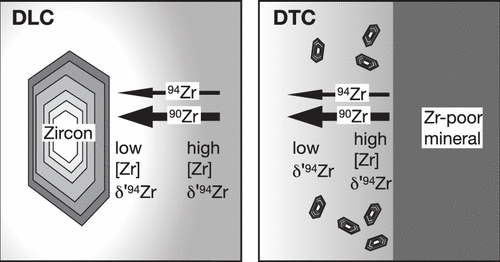当前位置:
X-MOL 学术
›
ACS Earth Space Chem.
›
论文详情
Our official English website, www.x-mol.net, welcomes your feedback! (Note: you will need to create a separate account there.)
Evidence from Ab Initio and Transport Modeling for Diffusion-Driven Zirconium Isotopic Fractionation in Igneous Rocks
ACS Earth and Space Chemistry ( IF 3.4 ) Pub Date : 2020-08-18 , DOI: 10.1021/acsearthspacechem.0c00146 Xi Chen 1 , Wenzhong Wang 2, 3 , Zhe Zhang 1 , Nicole Xike Nie 4 , Nicolas Dauphas 1
ACS Earth and Space Chemistry ( IF 3.4 ) Pub Date : 2020-08-18 , DOI: 10.1021/acsearthspacechem.0c00146 Xi Chen 1 , Wenzhong Wang 2, 3 , Zhe Zhang 1 , Nicole Xike Nie 4 , Nicolas Dauphas 1
Affiliation

|
We use density functional theory to calculate the equilibrium isotopic fractionation factors of zirconium (Zr) in a variety of minerals including zircon, baddeleyite, Ca-catapleiite, ilmenite, geikielite, magnetite, apatite, K-feldspar, quartz, olivine, clinopyroxene, orthopyroxene, amphibole, and garnet. We also report equilibrium isotopic fractionation factors for Hf in zircons, Ca-catapleiite, and ilmenite. These calculations show that coordination environment is an important control on Zr and Hf isotopic fractionation, with minerals with Zr and Hf in low coordinations predicted to be enriched in the heavy isotopes of Zr and Hf, relative to those with Zr and Hf in high coordinations. At equilibrium, zircon, which hosts Zr and Hf in 8-fold coordination, is predicted to have low 94Zr/90Zr and 179Hf/177Hf ratios compared to silicate melt, which hosts Zr and Hf in 6-fold coordination. However, our modeling results indicate that little equilibrium isotopic fractionation for Zr is expected during magmatic differentiation and zircon crystallization. We show through isotopic transport modeling that the Zr isotopic variations that were documented in igneous rocks are likely due to diffusion-driven kinetic isotopic fractionation. The two settings where this could take place are (i) diffusion-limited crystallization of zircon (DLC model) and (ii) diffusion-triggered crystallization of zircon (DTC model) in the boundary layer created by the growth of Zr-poor minerals. Fractional crystallization of zircons enriched in light Zr isotopes by diffusion can drive residual magmas toward heavy Zr isotopic compositions. Our diffusive transport model gives the framework to interpret Zr isotope data and gain new insights into the cooling history of igneous rocks and the setting of zircon crystallization.
中文翻译:

火成岩中扩散驱动的锆同位素分馏的从头算和运输建模的证据
我们使用密度泛函理论来计算各种矿物中锆(Zr)的平衡同位素分馏因子,这些矿物包括锆石,baddeleyite,Ca-钙铝石,钛铁矿,geikielite,磁铁矿,磷灰石,K长石,石英,橄榄石,斜辉石,邻位辉石,角闪石和石榴石。我们还报告了锆石,钙质钙钛矿和钛铁矿中Hf的平衡同位素分馏因子。这些计算表明,配位环境是控制Zr和Hf同位素分馏的重要控制因素,相对于配位较高的Zr和Hf的矿物,低配位的Zr和Hf的矿物预计富含Zr和Hf的重同位素。处于平衡状态的锆石,其Zr和Hf具有8倍的配合,预计具有低的94 Zr / 90Zr和179 Hf / 177与硅酸盐熔体相比,Hf比高,硅酸盐熔体中Zr和Hf的配位为6倍。然而,我们的模拟结果表明,在岩浆分化和锆石结晶过程中,Zr的平衡同位素分馏几乎没有。我们通过同位素传输模型表明,火成岩中记录的Zr同位素变化很可能是由于扩散驱动的动力学同位素分馏所致。这可能发生的两个设置是(i)锆石的扩散受限结晶(DLC模型)和(ii)在贫锆矿物的生长所产生的边界层中锆石的扩散触发结晶(DTC模型)。通过扩散富集了轻Zr同位素的锆石的部分结晶可以驱使残留的岩浆流向重Zr同位素组成。
更新日期:2020-09-18
中文翻译:

火成岩中扩散驱动的锆同位素分馏的从头算和运输建模的证据
我们使用密度泛函理论来计算各种矿物中锆(Zr)的平衡同位素分馏因子,这些矿物包括锆石,baddeleyite,Ca-钙铝石,钛铁矿,geikielite,磁铁矿,磷灰石,K长石,石英,橄榄石,斜辉石,邻位辉石,角闪石和石榴石。我们还报告了锆石,钙质钙钛矿和钛铁矿中Hf的平衡同位素分馏因子。这些计算表明,配位环境是控制Zr和Hf同位素分馏的重要控制因素,相对于配位较高的Zr和Hf的矿物,低配位的Zr和Hf的矿物预计富含Zr和Hf的重同位素。处于平衡状态的锆石,其Zr和Hf具有8倍的配合,预计具有低的94 Zr / 90Zr和179 Hf / 177与硅酸盐熔体相比,Hf比高,硅酸盐熔体中Zr和Hf的配位为6倍。然而,我们的模拟结果表明,在岩浆分化和锆石结晶过程中,Zr的平衡同位素分馏几乎没有。我们通过同位素传输模型表明,火成岩中记录的Zr同位素变化很可能是由于扩散驱动的动力学同位素分馏所致。这可能发生的两个设置是(i)锆石的扩散受限结晶(DLC模型)和(ii)在贫锆矿物的生长所产生的边界层中锆石的扩散触发结晶(DTC模型)。通过扩散富集了轻Zr同位素的锆石的部分结晶可以驱使残留的岩浆流向重Zr同位素组成。


























 京公网安备 11010802027423号
京公网安备 11010802027423号